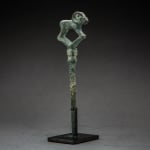Bactrian Bronze Pin with Animal Finial, 2500 BCE - 1700 BCE
bronze
height 19.4 cm
height 7 5/8 in
height 7 5/8 in
LO.1233
The Bactrio-Margiana Archeological Complex (BMAC) can be defined by the commonality of cultural expression, including bronze metallurgy throughout a vast geographical area encompassing modern Turkmenistan, Uzbekistan and northern Afghanistan. During...
The Bactrio-Margiana Archeological Complex (BMAC) can be defined by the commonality of cultural expression, including bronze metallurgy throughout a vast geographical area encompassing modern Turkmenistan, Uzbekistan and northern Afghanistan. During the late third and early second millennia BC, this area of western Central Asia produced a vast array of metal ornaments, attesting to a highly developed civilization, constituted by small fortified urban centres, connected by waterways and well engaged in trade and commerce with both sedentary and nomadic peoples.
At that time, local craftsmen were already well versed in the metallurgy of copper and arsenical copper and fully mastered the bronze fusion in moulds and lost wax, creating extremely complex forms both for ceremonial and utilitarian artifacts.
Our pin features a finial in the shape of a three-dimensional galloping ram, following a style encountered both in Margiana and Bactrian’s burial sites. Apparently bronze was mainly used by women, while the higher ranks of the male society could have afforded to be buried with gold and silver ornaments.
Artifacts from the region indicate that there were contacts with Iran to the southwest and these pins duly attest to the eastward influence of early Bronze Age Period Luristan art. Indeed Bactrian examples are usually less abstract, focusing prevalently on realistic zoomorphic subjects, such as the one here portrayed.
References: V. Sarianidi, Margus, 2002: pp. 112-113; and J. Aruz ed., Art of the First Cities, 2003.
At that time, local craftsmen were already well versed in the metallurgy of copper and arsenical copper and fully mastered the bronze fusion in moulds and lost wax, creating extremely complex forms both for ceremonial and utilitarian artifacts.
Our pin features a finial in the shape of a three-dimensional galloping ram, following a style encountered both in Margiana and Bactrian’s burial sites. Apparently bronze was mainly used by women, while the higher ranks of the male society could have afforded to be buried with gold and silver ornaments.
Artifacts from the region indicate that there were contacts with Iran to the southwest and these pins duly attest to the eastward influence of early Bronze Age Period Luristan art. Indeed Bactrian examples are usually less abstract, focusing prevalently on realistic zoomorphic subjects, such as the one here portrayed.
References: V. Sarianidi, Margus, 2002: pp. 112-113; and J. Aruz ed., Art of the First Cities, 2003.



